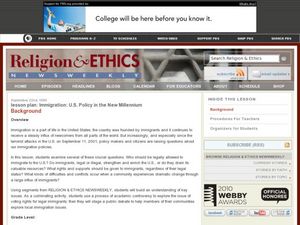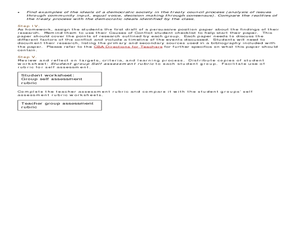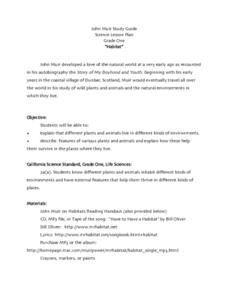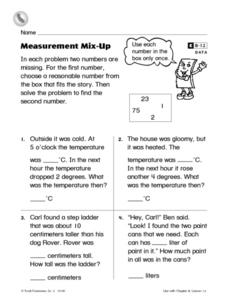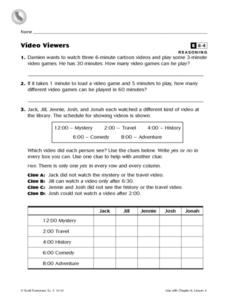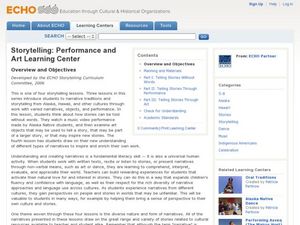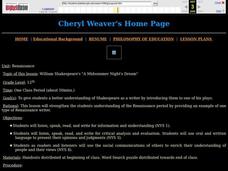Curated OER
Make a Table
In this making a table worksheet, 3rd graders make two tables to illustrate to scenarios and then read one completed table in order to answer 2 questions with multiple choice answers.
Curated OER
Immigration: U.S. Policy in the New Millennium
Students explore U.S. immigration policies. In this immigration lesson, students read about the history of immigration policies in the U.S., uncover controversial issues regarding immigration, and speak to immigrants as well as...
Curated OER
The Treaty Trail: US Indian Treaty Councils in the Northwest
Students research and examine primary sources concerning the Washington Territory. In this Native American removal lesson, students view portrait images created by Gustav Sohon. Students then read several biographies that correspond to...
Curated OER
"Habitat'
First graders explore and explain that different plants and animals live in different kinds of environments. They illustrate various plants and animals and how they survive in the places where they live. A nature journal for enrichment...
Curated OER
On the Road
In this visual thinking worksheet, 1st graders read and analyze a road map in order to circle the 5 multiple choice answers to 5 questions relating to the road map.
Curated OER
Subtraction Switch
In this subtraction sentences worksheet, students read the words in each problem and write the corresponding subtraction sentence and solve it. Example: You start with 43. The difference is 41. (43-2=41).
Curated OER
Measurement Mix-Up
In this measurement worksheet, 2nd graders read 4 word problems and find the two numbers missing in each one. Students choose a reasonable number from the box that fits the story for the first number and then solve the problem to find...
Curated OER
Story Problems
In this number sentence instructional activity, 2nd graders, working with a partner, read a short story, ask 6 questions relating to the story and then write 6 number sentences to answer each question.
Curated OER
Addition Riddles
In this addition riddles instructional activity, students read three clues and analyze the numbers in a 4 square grid. Students cross out numbers that do not fit the clues and determine the answer. There are 4 riddles on each page.
Curated OER
Video Viewers
In this video viewers worksheet, 3rd graders solve 2 word problems dealing with watching videos, read and analyze 4 clues in order to fill in a chart correctly involving 5 people and the types of videos they watch.
Curated OER
Scuba, Dooba, Do
In this money learning exercise, 3rd graders read a math scenario about 6 people going on a snorkeling trip. Students add together how much each person has to spend and what two items each person buys. Students choose 3 items they would...
Texas Education Agency (TEA)
Geometry in Architecture #1
Discover how to analyze architecture from a geometric standpoint. The fourth installment of an 11-part unit on architecture first provides a presentation on axis, balance, basic form, formal, pattern, proportion, symmetry, and tripartite...
Roy Rosenzweig Center for History and New Media
Patriots or Traitors - Point of View in the War for Independence
Patriots or traitors? Class members analyze images that present widely differing views of the Boston Tea Party, identifying the point of view of the image, the propaganda devices used, and the intended audience.
Curated OER
Gingerbread Baby v. Gingerbread Boy #7
Students read two stories. In this comparison lesson, students read "The Gingerbread Baby," by Jan Brett and the original "Gingerbread Boy." Students use a Venn Diagram to compare and contrast the two stories.
Griffen Publishing
Learning From the Past
The big idea for this lesson plan is that the past enriches our present and future. Learners explore the origin of the Olympic Games and how one man took an event from the past and reinvented it for modern times. They compare and...
Edgate
Learning From the Past: Origin of the Modern Summer Games
Where did our beloved Summer Games originate? Kids look for the origins of the Summer Olympics in our ancient past. They research how the Games came to be and how they have changed. They'll complete Venn diagrams to compare and contrast...
Curated OER
The Pumpkin Patch - A Venture in Agritourism
After reading an article about how agritourism is helping boost the financial stability of local farms, middle schoolers answer comprehension questions. This is a case-study of Canadian pumpkin producers. It could be useful as a...
Curated OER
Storytelling: Performance and Art Learning Center
Tenth graders explore the process of telling stories without words. In this literature lesson, 10th graders watch a music video performance made by Alaska Native students, and then examine art objects that may be used to tell a...
Curated OER
Hickory Dickory Doc Tell Time
Students discover time keeping by reading clocks. In this time-telling lesson, students read the story Hickory Dickory Dock, and discuss the measurements of time we use. Students complete worksheets in which they identify the...
Curated OER
Three is a Toxic Number
Future public health advocates read a case study of a combination of water pollutants that may be linked to autism. The class is split into three groups, one to research each of the suspected chemicals. The look at how each one affects...
Curated OER
Judicial Review
Students are introduced to the concept of judicial review. They read an article about this topic and the Bill of Rights. They answer discussion questions and review as a class.
Curated OER
Using Print Media in the LCTL Classroom
Explore newspapers as a form of print media. They examine headlines from newspapers and infer meanings of the headlines. They skim articles for information and exchange articles between groups. They complete charts while skimming the...
Curated OER
A Midsummer Night's Dream
You might not be able to put a girdle around the earth in forty minutes but you can generate interest in A Midsummer’s Night Dream in that length of time. As an introduction to Shakespeare’s comedy, pairs of students assume the roles of...
Curated OER
Judicial Review
Pupils review the concepts they were introduced to in a telecast on judicial review. After reading an article, they answer discussion questions and repeat the same procedure for another article. They participate in a debriefing session...

